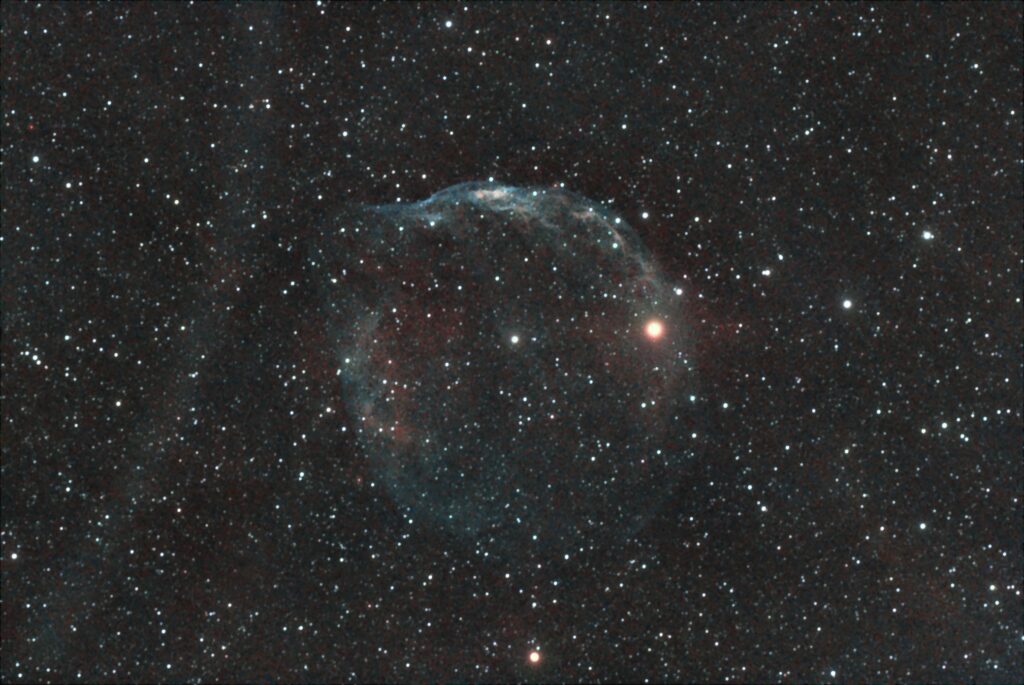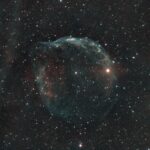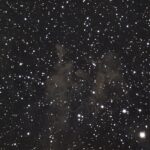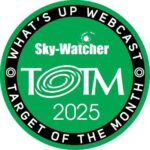
Clear and cold… very cold. I uncovered the scope a in the late afternoon. One thing about the cold is it doesn’t take long for the camera to cool down 🙂 After dark I ran the Ekos Auto Focus and Polar Alignment. Man it was cold there, glad I can do most of this from my desk.
Ekos Auto Focus set the steps to 10321. Plate solving calculated the focal length at 569.6 mm (F/5.6), I was after the Dolphin Head Nebula (Sh2-308 also LBN 1052) which is the January 2024 Sky-WatcherUSA TOTM. The Dolphin Head Nebula is pretty low in the southern sky and I knew I would only have a short period of time to capture light from it.
| Primary (Imaging) | Secondary (Guiding) |
|---|---|
| Scope: SVBONY SV503 102ED Reducer/Flattener: SVBONY SV193 0.8 FR/FF Filter: ZWO 2″ Duo-Band Filter Camera: ZWO ASI294 MC Pro, Cooled to -10 C Focuser: ZWO EAF Mount: Sky Watcher EQ6-R Pro |
Scope: SVBONY SV106 60mm Guide Scope Camera: Orion Star Shooter Autoguider (OSSAG) |
| Telescope Control, Image Acquisition, and Image Processing Software | |
|
Equipment Control and Imaging Software: KStars/Ekos connecting to INDI Server on a Raspberry Pi Stacking and Processing Software: Siril astronomical image processing tool |
|
Since I had a little bit to wait I did shoot a few frames of M42, the Orion Nebula. I will tinker around with them a bit later. I was able to get the Dolphin Head Nebula in the scope at around 8:45 PM. Checked focus and started guiding. Captured the first light at around 8:50 PM. Monitoring the frames in SharpCap, the very first image showed a faint bit of nebula. I let it run capturing 180 second exposures, but by 10:45 PM it was in the trees.
For calibration I am still using dark frames captured on 12/30/2023, they are working well and calibrating out the hot pixels and amp glow nicely. Since I am using the ZWO Duo-Band filter I shot a new set of flats at ADU 25000 on the morning of 01/21/2024. Darks and Flats are at the same camera temperature (-10), gain (121), and offset (30) as the lights. I used Sirilic to organize the darks, flats, and lights and then create the Siril script to stack them and extract the Ha and OIII. The pixel math I am using to combine the Ha and OIII is simply R = Ha, B = OIII, and G = OIII.
The Dolphin Head Nebula, Sh2-308 or LBN 1052, is a nebula in the constellation Canis Major. This is a stack of 37 x 180 second exposures, gain 121, offset 30, and bin 2×2. Stacked calibrated(flats and darks), cropped, flipped, and processed in Siril.

I was hoping to get some more time on this, but it was very low in the south. I ended up with only about 1 1/2 hours from it clearing the garage till it was in the trees. The 78% Moon did not help much either. In the upper part of the nebula there is some interesting structure details resolving pretty nicely, I can also just start to make out the dolphin “nose”.
Very interesting target. I hope I can add some more light to this over the next few nights or so (it suppose to be clear again tonight).
I created a page to track my 2024 Sky-WatcherUSA TOTM Submissions.








